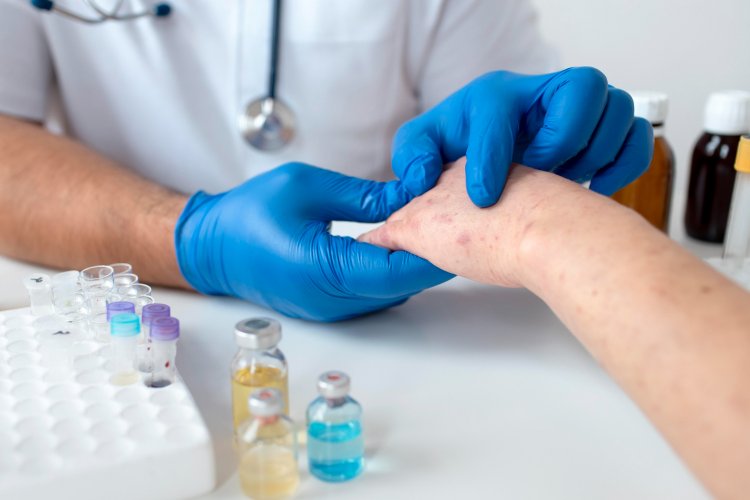Comprehensive Guide to Anaphylaxis: Understanding, Diagnosis, and Treatment
Anaphylaxis is a severe and potentially life-threatening allergic reaction that demands immediate medical attention. This comprehensive guide aims to delve deeper into the nuances of anaphylaxis, including its definition, causes, pathophysiology, clinical manifestations, diagnosis, and management strategies.

What is Anaphylaxis?
Anaphylaxis is an acute systemic hypersensitivity reaction resulting from the sudden release of inflammatory mediators, predominantly histamine, in response to an allergen. This exaggerated immune response can manifest rapidly and affect multiple organ systems, leading to severe clinical manifestations, including cardiovascular collapse, respiratory compromise, and shock.
Causes of Anaphylaxis
Anaphylaxis can be triggered by a diverse array of allergens, including but not limited to:
- Foods: Common allergenic foods such as peanuts, tree nuts, shellfish, fish, milk, eggs, wheat, and soy are notorious triggers for anaphylactic reactions.
- Medications: Various drugs, including antibiotics (e.g., penicillin, cephalosporins), nonsteroidal anti-inflammatory drugs (NSAIDs), radiocontrast media, and certain vaccines, can precipitate anaphylaxis.
- Insect Stings: Venom from stinging insects such as bees, wasps, hornets, and ants can provoke severe allergic reactions.
- Latex: Latex allergy, particularly prevalent among healthcare workers and individuals with frequent exposure to latex products, can lead to anaphylaxis upon contact.
- Exercise: Exercise-induced anaphylaxis is a rare but recognized phenomenon, often triggered by physical exertion following ingestion of specific foods or medications.
- Idiopathic: In some cases, the trigger for anaphylaxis remains unidentified, leading to a diagnosis of idiopathic anaphylaxis.
Pathophysiology of Anaphylaxis
The pathophysiology of anaphylaxis involves a cascade of immunological events initiated by the cross-linking of allergen-specific immunoglobulin E (IgE) antibodies bound to mast cells and basophils. Upon re-exposure to the allergen, these sensitized cells release a plethora of vasoactive mediators, including histamine, tryptase, leukotrienes, prostaglandins, and cytokines. These mediators exert their effects by inducing vasodilation, increasing vascular permeability, promoting smooth muscle contraction, and activating inflammatory cells, culminating in the characteristic systemic manifestations of anaphylaxis.
Clinical Manifestations of Anaphylaxis
Anaphylaxis manifests with a wide spectrum of clinical symptoms, which can vary in severity and onset time. Common manifestations include:
- Cutaneous Symptoms: Pruritus, urticaria (hives), angioedema (swelling of the deeper layers of the skin), erythema (redness), and flushing.
- Respiratory Symptoms: Dyspnea (shortness of breath), wheezing, stridor, cough, chest tightness, nasal congestion, and throat swelling (pharyngeal or laryngeal edema).
- Cardiovascular Symptoms: Hypotension (low blood pressure), tachycardia (rapid heart rate), palpitations, syncope (fainting), and cardiac arrest.
- Gastrointestinal Symptoms: Abdominal pain, nausea, vomiting, diarrhea, and fecal incontinence.
- Neurological Symptoms: Anxiety, confusion, dizziness, lightheadedness, altered consciousness, and seizures.
Diagnosis of Anaphylaxis
The diagnosis of anaphylaxis relies primarily on clinical criteria, encompassing both the acute onset of symptoms and the involvement of multiple organ systems. The National Institute of Allergy and Infectious Diseases (NIAID) and the Food Allergy and Anaphylaxis Network (FAAN) have established diagnostic criteria for anaphylaxis, emphasizing the rapidity of symptom development and the presence of respiratory or cardiovascular compromise. Additional diagnostic modalities, such as serum tryptase measurement, may aid in confirming the diagnosis and assessing the severity of the reaction.
Management of Anaphylaxis
Prompt and appropriate management is paramount in the treatment of anaphylaxis. The cornerstone of therapy is the immediate administration of epinephrine, the only medication capable of counteracting the systemic effects of anaphylaxis. Epinephrine acts by reversing peripheral vasodilation, restoring vascular tone, attenuating airway constriction, and alleviating mucosal edema. Intramuscular injection into the anterolateral aspect of the thigh is the preferred route of administration, with repeat doses as necessary in cases of ongoing or recurrent symptoms.
Adjunctive Treatments
In addition to epinephrine, adjunctive therapies may be employed to mitigate ongoing symptoms and prevent recurrence. These may include:
- Antihistamines: H1 antagonists (e.g., diphenhydramine) and H2 antagonists (e.g., ranitidine) can alleviate pruritus and urticaria but are not substitutes for epinephrine in the acute management of anaphylaxis.
- Corticosteroids: Systemic glucocorticoids (e.g., methylprednisolone, prednisone) may be administered to attenuate the late-phase inflammatory response and reduce the risk of biphasic reactions.
- Bronchodilators: Inhaled β2-agonists (e.g., albuterol) may be indicated for patients experiencing bronchospasm refractory to epinephrine.
Supportive Care
Supportive measures play a crucial role in optimizing patient outcomes during anaphylactic emergencies. These may encompass:
- Oxygen Therapy: Supplemental oxygen should be provided to patients with respiratory distress or hypoxemia to improve tissue oxygenation and alleviate respiratory compromise.
- Intravenous Fluids: Crystalloid solutions (e.g., normal saline) are administered to restore intravascular volume and mitigate hypotension in patients with significant fluid losses.
- Positioning: Patients should be placed in a supine position with their lower extremities elevated to enhance venous return and maintain cerebral perfusion, unless contraindicated by respiratory distress.
In conclusion, Anaphylaxis represents a critical medical emergency characterized by a rapid and systemic allergic reaction with potentially life-threatening consequences. Understanding the diverse triggers, underlying pathophysiology, clinical manifestations, diagnostic criteria, and management principles is essential for healthcare providers to promptly recognize, appropriately treat, and effectively manage anaphylactic reactions, thereby minimizing morbidity and mortality associated with this condition. Through comprehensive education, heightened awareness, and timely intervention, the impact of anaphylaxis on individuals and communities can be mitigated, fostering optimal health outcomes and enhancing overall quality of life.
Disclaimer
The information provided in this article is for educational purposes only and should not be considered medical advice. If you have any health concerns or are experiencing symptoms, it is important to consult with a healthcare professional, such as a doctor or clinic, for proper diagnosis and treatment. Always seek the advice of your doctor or other qualified health provider with any questions you may have regarding a medical condition. Do not disregard professional medical advice or delay in seeking it because of something you have read in this article.
Hashtags
#Anaphylaxis #AllergyAwareness #Health #EmergencyCare #MedicalEducation
What's Your Reaction?





















